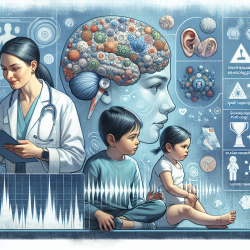Introduction
In the field of pediatric neurology, understanding the complex aftermath of Herpes Simplex Virus 1 (HSV1) encephalitis is crucial for improving patient outcomes. A recent case study published in Child Neurology Open provides a detailed examination of a unique clinical presentation involving startle seizures and diffuse leukoencephalopathy in a child post-HSV1 encephalitis. This blog explores the implications of these findings for practitioners and encourages further research into this rare condition.
Case Overview
The study detailed the case of a 17-month-old boy who developed startle seizures and diffuse white matter injury following the acute phase of HSV1 encephalitis. Initially treated with antiviral medication, the child was later readmitted with seizures provoked by sudden, loud sounds. MRI scans revealed diffuse leukoencephalopathy, a condition not previously associated with HSV1 encephalitis.
Clinical Implications
This case highlights the potential for post-acute phase complications in HSV1 encephalitis, underscoring the need for vigilant follow-up care. Practitioners should be aware of the possibility of startle seizures and white matter changes, even after successful antiviral treatment. Key considerations include:
- Monitoring for new-onset seizures and neurological changes post-treatment.
- Utilizing MRI and EEG to assess for leukoencephalopathy and seizure activity.
- Collaborating with a multidisciplinary team, including speech-language pathologists, to address developmental delays and communication challenges.
Encouraging Further Research
The case study opens avenues for further research into the mechanisms underlying startle seizures and leukoencephalopathy post-HSV1 encephalitis. Understanding the pathogenesis of these conditions could lead to improved treatment strategies and outcomes. Researchers are encouraged to explore:
- The role of neuronal hyperexcitability and immune responses in postencephalitic epilepsy.
- Potential genetic factors contributing to the unique clinical presentation.
- Long-term outcomes and effective management strategies for affected children.
Conclusion
This case study provides valuable insights into the complexities of post-HSV1 encephalitis complications. By integrating these findings into clinical practice, practitioners can enhance their skills and contribute to better outcomes for children with similar conditions. For those interested in delving deeper into the original research, please follow this link: Startle Seizures and Diffuse Leukoencephalopathy After Resolution of Herpes Simplex Virus 1 Encephalitis in a Child.










